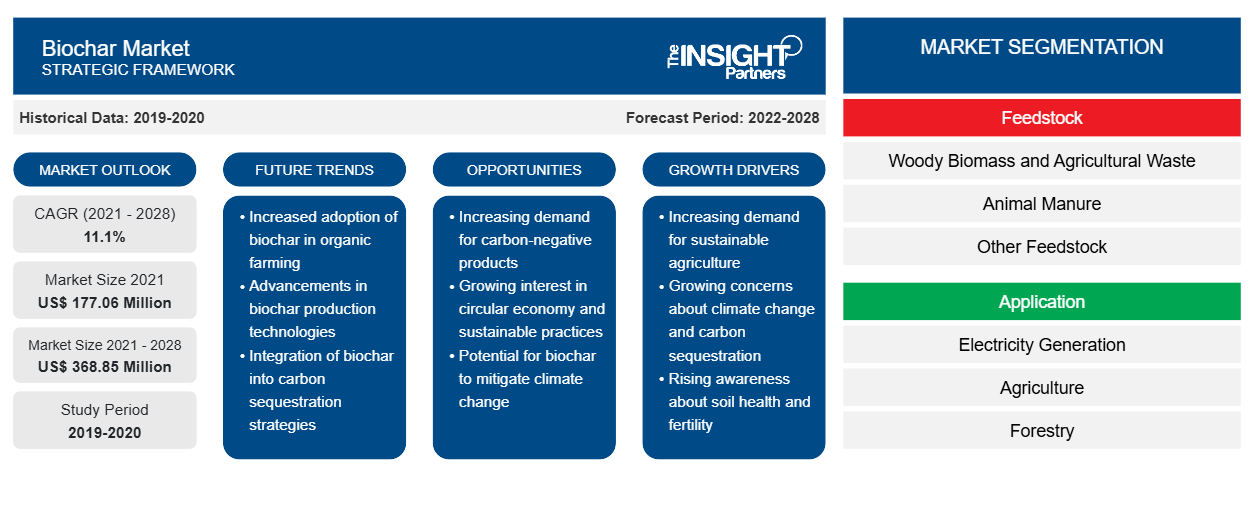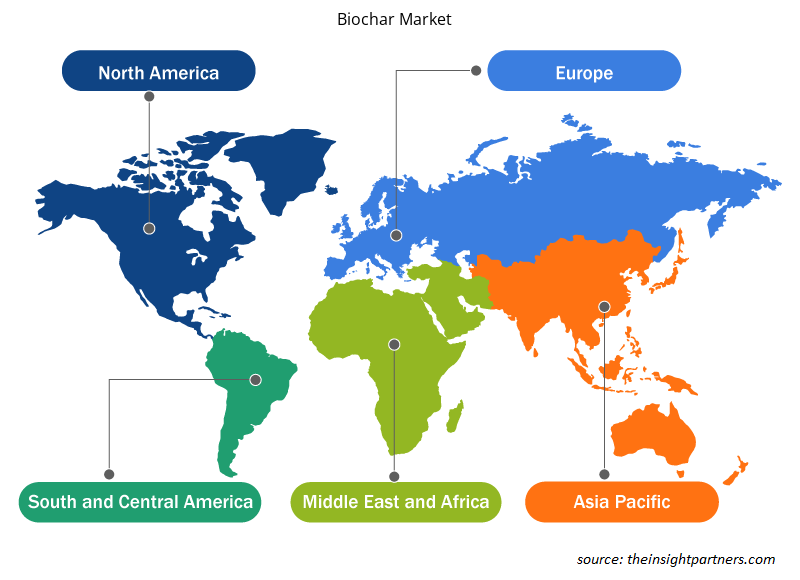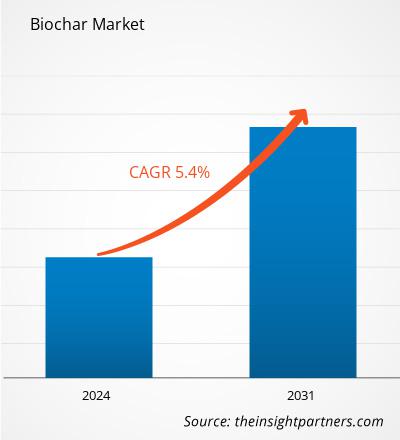The biochar market size is projected to reach US$ 277.04 million by 2031 from US$ 195.73 million in 2024. The market is expected to register a CAGR of 5.4% during 2025–2031. The increasing applications in wastewater management are likely to bring new trends in the biochar market in the coming years.
Biochar Market Analysis
Agriculture is one of the major application areas for biochar. In recent years, the interest in using biochar in agriculture has increased. The application of biochar to temperate soil can improve various soil health indicators. Soil health is determined by the capacity of the soil to function as a living system to sustain biological productivity and maintain environmental quality. Biochar has the potential to retain soil nutrients such as ammonium, nitrate, and phosphorus; this effect is most readily observed in light-textured soils. It also helps improve soil fertility and increases crop productivity. Further, the use of biochar in organic farming contributes to the production of food that is perceived as healthier in an environmentally friendly manner. Therefore, the increasing focus on organic farming is expected to offer lucrative opportunities for the biochar market growth during the forecast period.
Biochar Market Overview
The global biochar market is experiencing significant growth, driven by the increasing demand for sustainable solutions across agriculture, construction, waste management, and environmental remediation. One of the primary drivers is the growing awareness of biochar’s environmental benefits, particularly its ability to sequester carbon and improve soil health. As a result, farmers are adopting biochar to enhance soil fertility and water retention and reduce reliance on chemical fertilizers. With the increasing population globally, the demand for fertilizers to boost crop productivity is increasing. Biochar is widely used in fertilizers to improve nutrient content and water-holding capacity. With the increase in agricultural production across the globe, the demand for biochar is increasing.
Governments across the globe are promoting the practice of balancing the growth of the agricultural sector with other sectors of the economy. The growth of the agriculture industry worldwide is achieved by using organic fertilizer and biochar produced by pyrolysis or thermal decomposition of organic matter in an oxygen-starved chamber. When compared to other synthetic fertilizers, awareness about the benefits of biochar is very high. Further, the increasing knowledge among the farming community about the benefits of products such as biochar that help maintain soil fertility, acidity, and nutrient value content will drive the demand for biochar globally.
Customize This Report To Suit Your Requirement
You will get customization on any report - free of charge - including parts of this report, or country-level analysis, Excel Data pack, as well as avail great offers and discounts for start-ups & universities
Biochar Market: Strategic Insights

- Get Top Key Market Trends of this report.This FREE sample will include data analysis, ranging from market trends to estimates and forecasts.
Customize This Report To Suit Your Requirement
You will get customization on any report - free of charge - including parts of this report, or country-level analysis, Excel Data pack, as well as avail great offers and discounts for start-ups & universities
Biochar Market: Strategic Insights

- Get Top Key Market Trends of this report.This FREE sample will include data analysis, ranging from market trends to estimates and forecasts.
Biochar Market Drivers and Opportunities
Surge in Demand for Biochar in Agriculture
Soil degradation is a major concern faced by the global agriculture sector. Biochar is applied to degraded soils to enhance their quality. The material helps improve soil quality by enhancing soil structure, increasing water retention and aggregation, decreasing acidity, enhancing porosity, regulating nitrogen leaching, and improving microbial properties. It is also found to be beneficial in composting, as it helps reduce greenhouse gas emissions and prevent the loss of nutrients in compost materials. Further, biochar helps reduce the compost's ammonia losses, bulk density, and odor.
In North America, various regional groups support the production and use of biochar in the agriculture sector. For instance, the Pacific Northwest Biochar Atlas is a resource for biochar users and producers. Pacific Northwest Biochar Atlas provides guidance to farmers, gardeners, and other end users on the potential benefits of biochar. The California Biochar Association seeks to build a strong and cohesive state-wide voice advocating for the production and use of biochar in agriculture and other industries. Further, with its mission to engage stakeholders with the advantages of biochar as a tool for climate policy and agricultural benefit, the Sonoma Biochar Initiative would drive the demand for biochar in agricultural applications. Thus, the increase in demand for biochar in agriculture is driving the biochar market growth.
Increasing Focus on Organic Farming
The awareness of the benefits of organic food and the side effects of chemicals in food production is surging across the world. This factor drives the popularity of organic farming and organic crops. Organic farming practices prioritize soil health and fertility. As a natural soil amendment, biochar enhances soil structure, improves nutrient availability, and promotes microbial activity. Further, ensuring compliance with specific standards and regulations is inevitable in organic food production. Organic certifying bodies often mandate the use of approved inputs and practices, including organic soil amendments. Biochar, derived from organic sources, has been shown to improve plant growth by facilitating root development and improving stress tolerance, and it also fulfills the requirements for organic certification. Organic food producers prioritize plant health and natural disease resistance development by minimizing synthetic pesticides and fertilizers.
Biochar Market Report Segmentation Analysis
Key segments that contributed to the derivation of the biochar market analysis are form, process, and application.
- In terms of form, the market is segmented into granular, powder, and pellets. The powder segment held the largest share of the market in 2024.
- Based on the process, the market is segmented into pyrolysis, gasification, torrefaction, and others. The pyrolysis segment held the largest share of the market in 2024.
- In terms of application, the market is categorized into agriculture, animal feed, water treatment, electricity generation, construction, and others. The agriculture segment accounted for the largest share of the market in 2024.
Biochar Market Share Analysis by Geography
The geographic scope of the biochar market report is divided into five regions: North America, Asia Pacific, Europe, Middle East & Africa, and South & Central America. The biochar market in Asia Pacific is expected to grow significantly during the forecast period.
The agricultural sector in Asia Pacific is expanding rapidly due to the increasing demand for organic produce, driven by awareness of the environmental impacts of chemical fertilizers. India and China are among the largest growers of organic rice and other crops. The Chinese organic product industry is growing constantly, and it recorded sales worth US$ 14 billion in 2023. The government promotes sustainable development goals through supportive regulations and initiatives. According to the Research Institute of Organic Agriculture, China is a leading producer of temperate fruits such as apples and organic oilseeds. In 2022, organic practices were implemented in ~126,000 ha of orchards and ~506,000 ha of organic oilseed farmlands.
Biochar Market Regional Insights
The regional trends and factors influencing the Biochar Market throughout the forecast period have been thoroughly explained by the analysts at Insight Partners. This section also discusses Biochar Market segments and geography across North America, Europe, Asia Pacific, Middle East and Africa, and South and Central America.

- Get the Regional Specific Data for Biochar Market
Biochar Market Report Scope
| Report Attribute | Details |
|---|---|
| Market size in 2024 | US$ 195.73 Million |
| Market Size by 2031 | US$ 277.04 Million |
| Global CAGR (2025 - 2031) | 5.4% |
| Historical Data | 2021-2023 |
| Forecast period | 2025-2031 |
| Segments Covered |
By Form
|
| Regions and Countries Covered | North America
|
| Market leaders and key company profiles |
Biochar Market Players Density: Understanding Its Impact on Business Dynamics
The Biochar Market market is growing rapidly, driven by increasing end-user demand due to factors such as evolving consumer preferences, technological advancements, and greater awareness of the product's benefits. As demand rises, businesses are expanding their offerings, innovating to meet consumer needs, and capitalizing on emerging trends, which further fuels market growth.
Market players density refers to the distribution of firms or companies operating within a particular market or industry. It indicates how many competitors (market players) are present in a given market space relative to its size or total market value.
Major Companies operating in the Biochar Market are:
- BC Biocarbon
- SOLER Group
- Green Man Char-Cyclic Carbon Pty Ltd
- American BioCarbon
- Elkem ASA
- Carbonis GmbH & Co KG
Disclaimer: The companies listed above are not ranked in any particular order.

- Get the Biochar Market top key players overview
Biochar Market News and Recent Developments
The biochar market is evaluated by gathering qualitative and quantitative data post primary and secondary research, which includes important corporate publications, association data, and databases. A few of the key developments in the biochar market are mentioned below:
- BluSky Carbon Inc., an innovative entry into the carbon removal clean technology sector, announced that it had commenced production of biochar at a dedicated facility in Arkansas. (Source: BluSky Carbon Inc, Press Release, October 2024)
- Sustainable infrastructure capital provider Nexus Development Capital announced a US$ 5 million investment in carbon removal startup Standard Biocarbon, aimed at supporting the development and scaling of its new biochar production facility. (Source: Standard Biocarbon, Press Release, January 2024)
Biochar Market Report Coverage and Deliverables
The "Biochar Market Size and Forecast (2021–2031)" report provides a detailed analysis of the market covering below areas:
- Biochar market size and forecast at global, regional, and country levels for all the key market segments covered under the scope
- Biochar market trends, as well as market dynamics such as drivers, restraints, and key opportunities
- Detailed Porter's Five Forces and SWOT analysis
- Biochar market analysis covering key market trends, global and regional framework, major players, regulations, and recent market developments
- Industry landscape and competition analysis covering market concentration, heat map analysis, prominent players, and recent developments in the biochar market
- Detailed company profiles
Frequently Asked Questions
Which region dominated the biochar market in 2024?
Asia Pacific dominated the market in 2024.
What are the driving factors impacting the biochar market?
The demand for biochar in agriculture and energy production is one of the factors driving the market.
What are the future trends of the biochar market?
The increasing applications in wastewater management are likely to bring new trends in the biochar market in the coming years.
What is the estimated value of the biochar market by 2031?
The market size is projected to reach US$ 277.04 million by 2031.
Which are the leading players operating in the biochar market?
BC Biocarbon, SOLER Group, Green Man Char-Cyclic Carbon Pty Ltd, American BioCarbon, Elkem ASA, Carbonis GmbH & Co KG, Element Biocarbon, Oregon Biochar Solutions, Envigas AB, BioCarbon Australia, Glanris, Genesis Enterprises Inc, Biochar Supreme LLC, Phoenix Energy, and Olivketts Global Energy Ltd are a few key players operating in the market.
- Historical Analysis (2 Years), Base Year, Forecast (7 Years) with CAGR
- PEST and SWOT Analysis
- Market Size Value / Volume - Global, Regional, Country
- Industry and Competitive Landscape
- Excel Dataset
Testimonials
Reason to Buy
- Informed Decision-Making
- Understanding Market Dynamics
- Competitive Analysis
- Identifying Emerging Markets
- Customer Insights
- Market Forecasts
- Risk Mitigation
- Boosting Operational Efficiency
- Strategic Planning
- Investment Justification
- Tracking Industry Innovations
- Aligning with Regulatory Trends
Yes! We provide a free sample of the report, which includes Report Scope (Table of Contents), report structure, and selected insights to help you assess the value of the full report. Please click on the "Download Sample" button or contact us to receive your copy.
Absolutely — analyst assistance is part of the package. You can connect with our analyst post-purchase to clarify report insights, methodology or discuss how the findings apply to your business needs.
Once your order is successfully placed, you will receive a confirmation email along with your invoice.
• For published reports: You’ll receive access to the report within 4–6 working hours via a secured email sent to your email.
• For upcoming reports: Your order will be recorded as a pre-booking. Our team will share the estimated release date and keep you informed of any updates. As soon as the report is published, it will be delivered to your registered email.
We offer customization options to align the report with your specific objectives. Whether you need deeper insights into a particular region, industry segment, competitor analysis, or data cut, our research team can tailor the report accordingly. Please share your requirements with us, and we’ll be happy to provide a customized proposal or scope.
The report is available in either PDF format or as an Excel dataset, depending on the license you choose.
The PDF version provides the full analysis and visuals in a ready-to-read format. The Excel dataset includes all underlying data tables for easy manipulation and further analysis.
Please review the license options at checkout or contact us to confirm which formats are included with your purchase.
Our payment process is fully secure and PCI-DSS compliant.
We use trusted and encrypted payment gateways to ensure that all transactions are protected with industry-standard SSL encryption. Your payment details are never stored on our servers and are handled securely by certified third-party processors.
You can make your purchase with confidence, knowing your personal and financial information is safe with us.
Yes, we do offer special pricing for bulk purchases.
If you're interested in purchasing multiple reports, we’re happy to provide a customized bundle offer or volume-based discount tailored to your needs. Please contact our sales team with the list of reports you’re considering, and we’ll share a personalized quote.
Yes, absolutely.
Our team is available to help you make an informed decision. Whether you have questions about the report’s scope, methodology, customization options, or which license suits you best, we’re here to assist. Please reach out to us at sales@theinsightpartners.com, and one of our representatives will get in touch promptly.
Yes, a billing invoice will be automatically generated and sent to your registered email upon successful completion of your purchase.
If you need the invoice in a specific format or require additional details (such as company name, GST, or VAT information), feel free to contact us, and we’ll be happy to assist.
Yes, certainly.
If you encounter any difficulties accessing or receiving your report, our support team is ready to assist you. Simply reach out to us via email or live chat with your order information, and we’ll ensure the issue is resolved quickly so you can access your report without interruption.















The List of Companies - Biochar Market
- BC Biocarbon
- SOLER Group
- Green Man Char-Cyclic Carbon Pty Ltd
- American BioCarbon
- Elkem ASA
- Carbonis GmbH & Co KG
- Element Biocarbon
- Oregon Biochar Solutions
- Envigas AB
- BioCarbon Australia
- Glanris
- Genesis Enterprises Inc
- Biochar Supreme LLC
- Phoenix Energy
- Olivketts Global Energy Ltd






 Get Free Sample For
Get Free Sample For